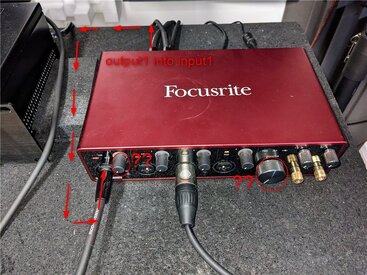MTP
Registered
Thread Starter
- Joined
- Sep 11, 2023
- Posts
- 2
More
- Additional Amp
- Behringer Reference A800
- Computer Audio
- Focustrite Scarlett 18i8
- Front Speakers
- Alesis Monitor One Mk2
- Video Display Device
- EVGA 3090
Hi there,
Possibly a bit of a stupid question.
Soundcard calibration to create soundcard calibration file.
I'm currently using REW for the first time and I've done my research watching several YouTube videos and reading the relevant REW documentation but I cant find any reference to this particular 'bit' of the soundcard calibration:
Focusrite Scarlett 18i8
Output 1 - Scarlett output 1
Input - Scarlett Input 1
(I'm running a TRS from output1 back into input1 for the loopback)
this bit is fine, I've done this before using Reaper to get the scarletts sample offset value.
What I cannot find anywhere, is when you press next to start the calibration and it sends the tone through the loop back and you have to adjust your input gain to match the output gain of -12dBFS,
you have TWO dials you can turn, the monitor OUT 'volume' dial on the scarlett and and Input 1's gain dial.
what do you set these at?!?
do you set the input 1 gain to max and then use the monitor dial to get to -12dBFS
or do you set the monitor dial to max and dial in the gain on input one to get to -12dBFS?
or do you set them both in the middle and go from there?
theres nothing in the video's or documentation I've watched/read other than one video saying to turn up the monitor output dial (but makes no mention of the gain dial on the input signal)
Possibly a bit of a stupid question.
Soundcard calibration to create soundcard calibration file.
I'm currently using REW for the first time and I've done my research watching several YouTube videos and reading the relevant REW documentation but I cant find any reference to this particular 'bit' of the soundcard calibration:
Focusrite Scarlett 18i8
Output 1 - Scarlett output 1
Input - Scarlett Input 1
(I'm running a TRS from output1 back into input1 for the loopback)
this bit is fine, I've done this before using Reaper to get the scarletts sample offset value.
What I cannot find anywhere, is when you press next to start the calibration and it sends the tone through the loop back and you have to adjust your input gain to match the output gain of -12dBFS,
you have TWO dials you can turn, the monitor OUT 'volume' dial on the scarlett and and Input 1's gain dial.
what do you set these at?!?
do you set the input 1 gain to max and then use the monitor dial to get to -12dBFS
or do you set the monitor dial to max and dial in the gain on input one to get to -12dBFS?
or do you set them both in the middle and go from there?
theres nothing in the video's or documentation I've watched/read other than one video saying to turn up the monitor output dial (but makes no mention of the gain dial on the input signal)















